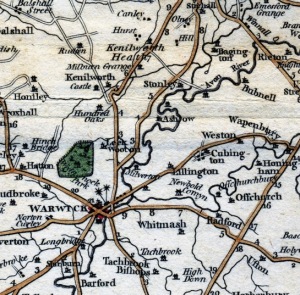Warwick, the capital of the county, is an ancient and neat town situated upon a rocky eminence above the Avon. The principal church, dedicated to St. Mary, which was in great part destroyed by a dreadful fire in 1694, and since rebuilt, preserves of its ancient structure, the choir, and the chapel of Our Lady, commonly called the Beauchamp chapel. This last was erected in the reigns of Henry VI and Edward IV, in pursuance of the will of Richard Beauchamp, earl of Warwick; and is a beautiful specimen of the taste of the age, both in its exterior architecture, and its interior ornaments. It contains a monument of the founder, regarded as inferior in splendour to none in the kingdom, except that of Henry VII chapel in Westminster abbey. There is also a monument of Robert Dudley, the celebrated earl of Leicester, with his countess; and records of others of the Dudley family. The only other church is dedicated to St. Nicholas.
The County Hall is a handsome and spacious building, erected about the middle of the last century. The Courthouse, or Town Hall, which was built soon after the great fire, is a respectable edifice. The County Gaol is an extensive and well-designed modern fabric. Warwick, though not distinguished as a town of trade, carries on some manufactures of recent introduction, among which are the spinning wool, and the preparing of worsted, for the hosiery manufacture, and the weaving of calicoes and other goods in the cotton branches.
Text: England Described etc (1818) by John Aikin M.D.
Map: Section from Warwickshire (1809) by John Cary
Jane Austen References
The Novels
Pride and Prejudice : Chapter 42






